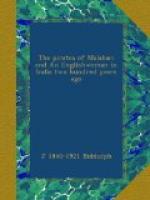At the beginning of November, the tide turned. News having been received that some of Angria’s grabs were cruising off Warlee, the Victoria and Revenge, manned with crews from the Salisbury, were sent out. After a hot engagement, Angria’s commodore, a Dutchman, was killed, and his ship, mounting sixteen guns, taken.
On the same day that the captured ship was brought into Bombay, two other captures entered the harbour. The Directors had sent out from England three galleys, the Bombay, the Bengal, and the Fort St. George, manned with sailors from the Thames. As they were proceeding up the coast they found themselves dogged for two days by two strange grabs showing no colours. Resolved to put an end to it, on the third day, on the 1st November, off Cape Ramus, they shortened sail and called on the strangers to show their colours. They proved to be Portuguese, and the English hails were answered by threats and shouts of defiance. The Bengal then fired a shot across the bows of the leading grab, which was answered by a broadside, killing the second mate and two seamen. The Bombay closed in, while the Fort St. George turned its attention to the second grab. In half an hour both of the Portuguese vessels struck their colours, and the galleys continued their course for Bombay with their two prizes, each carrying twenty guns. Such was the difference made by having British seamen, instead of the miserable crews that had hitherto manned the Company’s ships.
It was well for the Bombay Council that Matthews had been absent while this was going on. For two months and a half he had remained at anchor in the Hooghly. Early in December he reached Bombay, and at once recommenced his quarrels with the Council and his captains. Cockburn, of the Salisbury, was placed under arrest, presumably for the assistance he had given to the Council. After a time he was transferred to the Exeter, and ordered to proceed to England.
In coming up the coast Matthews had touched at Goa, and informed the Viceroy of his disapproval of the Company’s actions, and that his squadron would soon be leaving the Indian seas. But the Viceroy had had enough fighting. The capture of his grabs had brought him to reason. He laid all the blame for recent hostilities on the General of the North, and a peaceful accommodation was come to with the Council, Matthews being disregarded.
In spite of Matthews’ failure to destroy the Madagascar pirates, the presence of his squadron in Indian waters impelled them to seek safety in the West Indies, and henceforward they ceased to be dangerous to the trade-ships of India. The Madagascar settlements lingered on till they died a natural death. Angria, too, had been tamed by the slaying of his commodore and the capture of his ships. For years the sea-borne trade of Bombay had not been so little subject to molestation as it was for the next three or four years.




